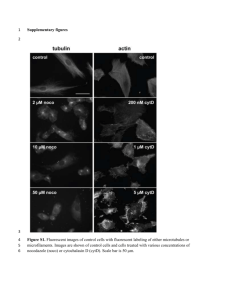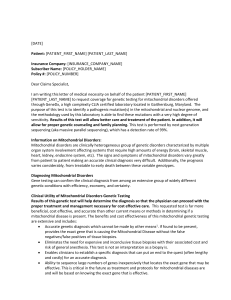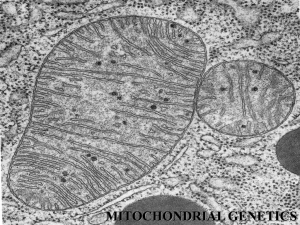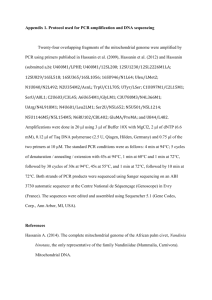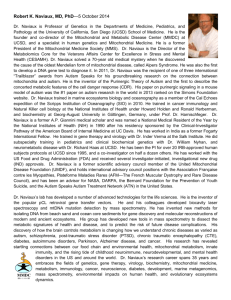Mitochondrial dysfunction-related genes in hepatocellular carcinoma
advertisement
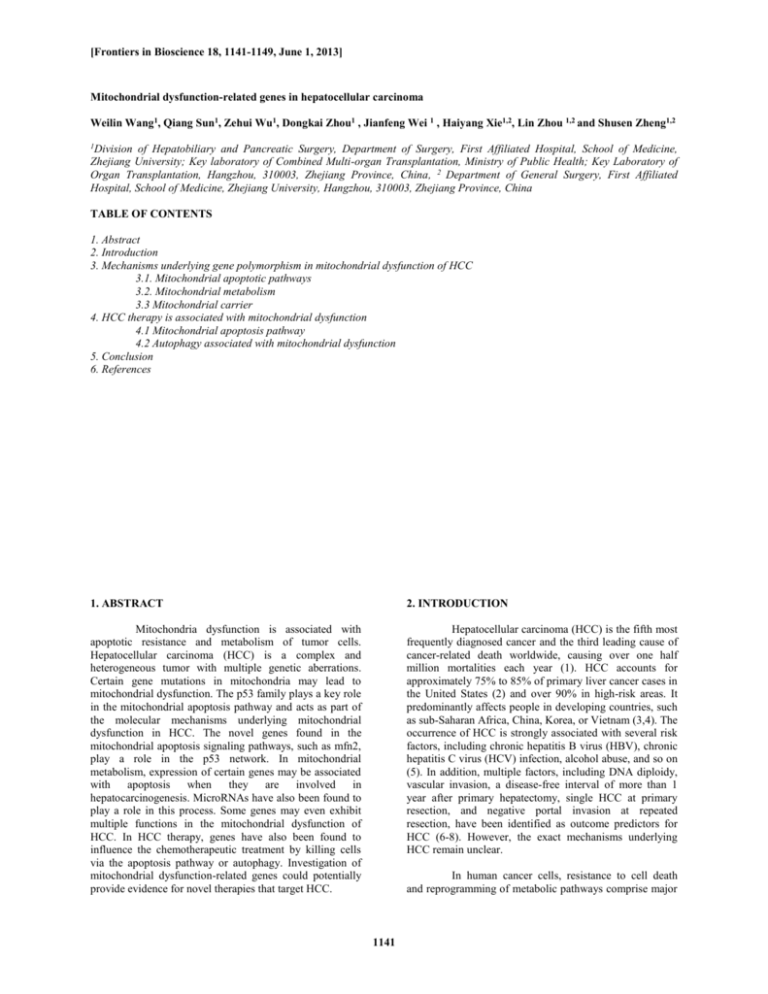
[Frontiers in Bioscience 18, 1141-1149, June 1, 2013] Mitochondrial dysfunction-related genes in hepatocellular carcinoma Weilin Wang1, Qiang Sun1, Zehui Wu1, Dongkai Zhou1 , Jianfeng Wei 1 , Haiyang Xie1,2, Lin Zhou 1,2 and Shusen Zheng1,2 1Division of Hepatobiliary and Pancreatic Surgery, Department of Surgery, First Affiliated Hospital, School of Medicine, Zhejiang University; Key laboratory of Combined Multi-organ Transplantation, Ministry of Public Health; Key Laboratory of Organ Transplantation, Hangzhou, 310003, Zhejiang Province, China, 2 Department of General Surgery, First Affiliated Hospital, School of Medicine, Zhejiang University, Hangzhou, 310003, Zhejiang Province, China TABLE OF CONTENTS 1. Abstract 2. Introduction 3. Mechanisms underlying gene polymorphism in mitochondrial dysfunction of HCC 3.1. Mitochondrial apoptotic pathways 3.2. Mitochondrial metabolism 3.3 Mitochondrial carrier 4. HCC therapy is associated with mitochondrial dysfunction 4.1 Mitochondrial apoptosis pathway 4.2 Autophagy associated with mitochondrial dysfunction 5. Conclusion 6. References 1. ABSTRACT 2. INTRODUCTION Mitochondria dysfunction is associated with apoptotic resistance and metabolism of tumor cells. Hepatocellular carcinoma (HCC) is a complex and heterogeneous tumor with multiple genetic aberrations. Certain gene mutations in mitochondria may lead to mitochondrial dysfunction. The p53 family plays a key role in the mitochondrial apoptosis pathway and acts as part of the molecular mechanisms underlying mitochondrial dysfunction in HCC. The novel genes found in the mitochondrial apoptosis signaling pathways, such as mfn2, play a role in the p53 network. In mitochondrial metabolism, expression of certain genes may be associated with apoptosis when they are involved in hepatocarcinogenesis. MicroRNAs have also been found to play a role in this process. Some genes may even exhibit multiple functions in the mitochondrial dysfunction of HCC. In HCC therapy, genes have also been found to influence the chemotherapeutic treatment by killing cells via the apoptosis pathway or autophagy. Investigation of mitochondrial dysfunction-related genes could potentially provide evidence for novel therapies that target HCC. Hepatocellular carcinoma (HCC) is the fifth most frequently diagnosed cancer and the third leading cause of cancer-related death worldwide, causing over one half million mortalities each year (1). HCC accounts for approximately 75% to 85% of primary liver cancer cases in the United States (2) and over 90% in high-risk areas. It predominantly affects people in developing countries, such as sub-Saharan Africa, China, Korea, or Vietnam (3,4). The occurrence of HCC is strongly associated with several risk factors, including chronic hepatitis B virus (HBV), chronic hepatitis C virus (HCV) infection, alcohol abuse, and so on (5). In addition, multiple factors, including DNA diploidy, vascular invasion, a disease-free interval of more than 1 year after primary hepatectomy, single HCC at primary resection, and negative portal invasion at repeated resection, have been identified as outcome predictors for HCC (6-8). However, the exact mechanisms underlying HCC remain unclear. In human cancer cells, resistance to cell death and reprogramming of metabolic pathways comprise major 1141 Mitochondrial dysfunction and genes in HCC hallmarks, and also cause inefficacy of chemotherapy (9). Mitochondria, which are crucial for cellular energy production and cell survival, are major regulators in the intrinsic apoptotic pathway (10). Thus, mitochondrial dysfunction promotes HCC progression. Cancer cells exhibit defects in the regulatory genes that govern normal cell proliferation and homeostasis due to progressive accumulation of mutations. Certain gene mutations in mitochondria potentially lead to mitochondrial dysfunction, which evolves into hepatocarcinogenesis. Freisinger and colleagues reported in patients with deoxyguanosine kinase (DGUOK) -related mitochondrial DNA (mtDNA) depletion syndrome, HCC was identified pathologically, suggesting the possible link between mtDNA mutation and HCC (11). In human HCC samples, 13 somatic mutations in the coding region of mtDNAs have been identified (12). Among these 13 mtDNA mutations, the T1659C transition in tRNA(Val) gene and G5650A in tRNA(Ala) gene were reported to be clinically associated with mitochondrial disorders. In addition, the T6787C (cytochrome c oxidase subunit I, COI), G7976A (COII), G9267A (COIII), and A11708G (ND4) mutations may result in amino acid substitutions in the highly conserved regions of the affected mitochondrial genes. These mtDNA mutations (10/13, 76.9%) have the potential to cause mitochondrial dysfunction in HCC (12). Thus, gene polymorphisms may participate in mitochondrial dysfunction in HCC. In this review, we discuss the role of mitochondrial dysfunctionrelated genes in HCC. metabolism; thus, we discuss the mechanisms underlying gene polymorphism in the mitochondrial dysfunction of HCC. 3.1. Mitochondrial apoptotic pathways Mitochondrial dysfunction is one of the crucial events involved in apoptotic cell death. Accumulating evidence suggests that apoptotic pathways converge at the mitochondria; signaling is initiated via a series of molecular events that culminate in the release of death factors (21). Gene polymorphisms in mitochondrial apoptotic pathways usually play a role in the apoptosis of hepatoma cells. Heat shock protein 70 (HSP70), abundantly expressed in human tumors, protects cells from a wide range of apoptotic stimuli. HSP70 potentially modulates mitochondrial protein apoptosis-inducing factor (AIF)induced cell death. Furthermore, HSP70 silencing has been shown to dramatically increase AIFDelta1-120 mutant (an active form of AIF after deletion of the mitochondria localization domain)-induced apoptosis (22). On the other hand, the potential pro-apoptotic molecule in HCC cells exhibits a gene polymorphism associated with mitochondrion. Fragile histidine triad (FHIT) is a confirmed tumor suppressor gene in HCC. Yu and colleagues (23) found that transactivator of transcription (TAT)-FHIT robustly inhibits growth and induces apoptosis of HCC cells in vitro; furthermore, they demonstrated that both exogenous and intrinsic apoptotic pathways are involved in TAT-FHIT-mediated apoptosis, and that this effect may be partially attenuated by mitochondrial protector TAT-BH4. These findings indicate that mitochondria play a critical role in TAT-FHITmediated pro-apoptotic effects in cancer cells. TAT-FHIT is a potential pro-apoptotic molecule in HCC cells. The tumor suppressive mechanism of the tyrosine aminotransferase gene has also been shown to play a proapoptotic role in a mitochondrial-dependent manner by promoting cytochrome-c release and activating caspase-9 and PARP (24). Moreover, a novel gene, homo sapiens longevity assurance homologue 2 (LASS2), has been isolated from a human liver cDNA library, a human homologue of the yeast longevity assurance gene LAG1 (Saccharomyces cerevisiae longevity assurance gene 1) (25). The LASS2 gene may increase intracellular H(+) of HCC cells via interaction with V-ATPase, thereby inducing cell apoptosis through the mitochondrial pathway. 3. Mechanisms underlying gene polymorphism in mitochondrial dysfunction of HCC The molecular mechanisms underlying hepatocarcinogenesis are very complex. Hepatocarcinogenesis is considered a multistep process involving subsequent gene mutations which control proliferation and/or apoptosis in the hepatocytes. Mitochondrial dysfunction-related genes are involved in the mechanisms underlying HCC. For instance, mitochondrial genes have been found to be differentially expressed in HBV X protein (HBx)-positive hepatoma cells (13, 14). Furthermore, three clones were shown to be human mitochondrial ATPase subunit 6 (mtATPase 6) (14). The HBx is a ubiquitous transactivator in HBV, which is essential for HBV replication in vivo. Mice expressing HBx in the liver may either develop HCC spontaneously (15) or display increased susceptibility to hepatocarcinogens (16). The introduction of HBx into HCC cell line Hep3B cells may induce apoptosis and sensitize Hep3B cells to TNFalpha-mediated cell killing; these processes may be accomplished via inhibition of Bcl-xL expression and subsequent promotion of cytochrome c release from mitochondria (17). In addition, the evidence gathered from epidemiological studies has demonstrated the connection between chronic HCV infection and the development of HCC (18,19). Additionally, in a mouse model of HCVassociated HCC, a deletion in mtDNA was reported (20). Taken together, these reports suggest the involvement of mitochondrial dysfunction-related genes in the pathogenesis of HCC. The function of mitochondria is associated with apoptosis, mitochondrial carriers, and Transforming growth factor-beta (TGF-beta) is a potent inhibitor of hepatocyte growth (26), and is known to induce apoptosis in both hepatocytes and HCC cell lines (27,28). One of the mediators of the TGF-beta pathway is the Smad family of genes, and candidate tumor suppressor genes in Smad2 and Smad4 gene mutations have been identified in HCC; these mutations were suspected to result from oxidative stress, as observed in mtDNA (29). More recently, Zhang and colleagues (30) found that TGF-beta1 treatment of Huh7 cells resulted in increased PDCD4 expression and apoptosis, concomitant with mitochondrial events. The human HCC cell line Huh7 transfected with PDCD4 resulted in increases of cytosolic cytochrome c and mitochondrial Bax, which was accompanied with decreases 1142 Mitochondrial dysfunction and genes in HCC Figure 1. Genes in the TGF-beta pathway or downstream of TGF-beta promote apoptosis due to mitochondrial changes. One of the mediators of the TGF-beta pathway is the Smad family of genes, and candidate tumor suppressor genes in Smad2 and Smad4 gene mutations have been identified in HCC; these mutations were suspected to result from oxidative stress, as observed in mtDNA. The human HCC cell line Huh7 transfected with PDCD4 resulted in increases of cytosolic cytochrome c and mitochondrial Bax, which accompanied with decreases of mitochondrial cytochrome c and cytosolic Bax, then inducing apoptosis. of mitochondrial cytochrome c and cytosolic Bax, then inducing apoptosis. Thus, genes in the TGF-beta pathway or downstream of TGF-beta could promote apoptosis due to mitochondrial changes (Figure 1). p53R175H, p53R248W, and p53R273H, can acquire antiapoptotic gain-of-function in HCC by repressing the activity of genes that regulate both the extrinsic apoptosis pathway initiated by ligation of death receptors and the intrinsic/mitochondrial apoptosis pathway. Furthermore, p53 gain-of-function mutants significantly decrease activation of pro-apoptotic target genes by wild-type p53, TAp63, and TAp73. This contributes to the ability of cancer cells to withstand DNA damage-induced apoptosis (39). TAp63 and TAp73 are the promoters of the Trp63 gene and Trp73 gene, respectively. In general, Trp63 gene and Trp73 gene have two respective promoters that drive the expression of two major p63 and p73 isoform subfamilies: TA and N-terminally truncated (DeltaN). TAp63 and TAp73 isoforms exhibit pro-apoptotic activities, whereas members of DeltaNp63 and DeltaNp73 subfamily exhibit antiapoptotic functions. Müller and colleagues (40) found that TAp73 beta could transactivate the CD95 gene via the p53-binding site in the first intron. Inhibition of CD95 gene transactivation was one mechanism by which DeltaNp73 functionally inactivated the tumor suppressor action of p53 and TAp73 beta. Concomitantly, DeltaNp73 inhibited the apoptosis emanating from mitochondria. Thus, DeltaNp73 expression in tumors selects against both the death receptor and the mitochondrial apoptosis activity of TAp73 beta. In HCC DeltaNp63alpha and DeltaNp73 beta expression interferes The tumor suppressor p53 gene plays a major role in preventing tumorigenesis by responding to both cellular stress and DNA damage; p53 mutation is frequently associated with oncogenesis (31,32). In some HCC cell lines, its activation leads to the induction of proapoptotic Bax expression (33,34), whereas pro-apoptotic Bax also antagonizes anti-apoptotic Bcl-2 and other antiapoptotic molecules. The mitochondria play a central role in apoptosis, which is regulated by members of the Bcl-2 family through an intrinsic apoptosis pathway (35-37). In p53-deficient Hep3B cells, apoptosis induced by pectenotoxin-2 (PTX-2) is associated with the downregulation of anti-apoptotic Bcl-2 members (Bcl-2 and BclxL) and IAP family proteins, and the up-regulation of proapoptotic Bax protein, tumor necrosis factor-related apoptosis-inducing ligand (TRAIL)-receptor 1/receptor 2 (DR4/DR5), and mitochondrial dysfunction (38). In contrast, interference with the p53 family network contributes to a gain of oncogenic function of mutant p53 in HCC via mitochondrial apoptotic pathway. Mutant forms of p53, including p53R143A, p53R175D, 1143 Mitochondrial dysfunction and genes in HCC Figure 2. Mfn2 exerts apoptotic effects and inhibits proliferation in HCC cells by the mitochondrial apoptotic pathway. Overexpression of mfn2 also induced cytochrome c release to the cytoplasm by enhancing Bax translocation from the cytoplasm to the mitochondrial membrane. Furthermore, HBx was shown to inhibit p53-mediated up-regulation of mfn2 in HCC cells. with both the death receptor and the mitochondrial apoptosis activity of the TA isoforms (41,42). DeltaNp63alpha could inhibit the activation of p53 family target genes (41), whereas DeltaNp73beta is oncogenic in HCC by blocking apoptosis signaling via death receptors and mitochondria (42). These findings suggest that DeltaNp63 and DeltaNp73 isoforms repress apoptosisrelated genes of mitochondrial apoptosis signaling pathways. initiated by cytochrome c release from mitochondria and is executed by the caspase family (52,53). Mutant forms of p53 and mfn2 genes play a role in the network. 3.2. Mitochondrial metabolism Enzymes produced from cytochrome P450 genes (CYP) are involved in the formation (synthesis) and breakdown (metabolism) of various molecules and chemicals within cells. Cytochrome P450 enzymes are primarily found in liver cells. Because the differential expression of CYP2E1 may play a pleiotropic role in the multistep process of liver carcinogenesis, Yang and colleagues (54) examined the effect of trichostatin A (TSA) on CYP2E1 expression and the role of CYP2E1 in inducing apoptosis of HepG2 cells; they found that TSA selectively induced CYP2E1 in human HCC cell lines (Huh7, PLC/PRF/5, Hep3B, and HepG2), but not in normal primary human hepatocytes. Moreover, TSA-mediated upregulation of CYP2E1 expression was associated with histone H3 acetylation and recruitment of HNF-1 and HNF3beta to the CYP2E1 promoter in HepG2 cells (54). These findings suggested that histone modification is involved in CYP2E1 gene expression and that CYP2E1-dependent mitochondrial oxidative stress plays a role in TSA-induced apoptosis. In addition, the adeno-associated virus (AAV)3mediated transfer and expression of the pyruvate dehydrogenase E1 alpha subunit gene could cause metabolic remodeling and apoptosis of human liver cancer cells (55). The mitochondrial GTPase mitofusin-2 gene (mfn2), also named hyperplasia suppressor gene (HSG), located on chromosome 1p22.3, encodes a mitochondrial membrane protein that participates in mitochondrial fusion and contributes to the maintenance of the mitochondrial network (43,44). It exhibits a potential apoptotic effect mediated by the mitochondrial apoptotic pathway (45-47). Qu and colleagues (48) reported that heterozygosity (LOH) at mfn2 gene in HCC is associated with clinicopathological features of patients, including tumor size, age, capsule, differentiation, and t HBV infection. Mfn2 was identified as a novel direct target of p53 that could also exert apoptotic effects via Bax signaling and potentially inhibits proliferation in HCC cells (49,50). Overexpression of mfn2 also induced cytochrome c release to the cytoplasm by enhancing Bax translocation from the cytoplasm to the mitochondrial membrane (50). Furthermore, the relationship between mfn2 and HBx was examined. HBx was shown to inhibit p53-mediated up-regulation of mfn2 in HCC cells, though HBx exhibited little effect on the expression of mfn2 or P53. (51) (Figure 2). Mutated expression of microRNAs (miRNAs) may contribute to HCC. MiRNA-122 is a regulator of mitochondrial metabolic gene network in HCC. Increased expression of miR-122 seed-matched genes leads to a loss of mitochondrial metabolic function. In vitro miR-122 data further provide a direct link between induction of miR-122controlled genes and impairment of mitochondrial metabolism (56). Because miR-122 regulates mitochondrial Novel genes in the mitochondrial apoptosis signaling pathways have been identified; however, the mechanisms of the p53 family network remain unclear in HCC. The activation of p53 can cause the induction of proapoptotic Bax expression, which antagonizes anti-apoptotic Bcl-2. Afterwards, the Bcl-2-mediated apoptotic process is 1144 Mitochondrial dysfunction and genes in HCC metabolism, its loss may be detrimental to sustaining critical liver function and may contribute to morbidity and mortality of liver cancer patients. Further elucidation of the miRNAs regulating mitochondrial metabolism, or other pathways in mitochondria, could potentially help with the development of novel HCC therapies. (69,70). Combined treatments using rapamycin and STAT3 gene silencing have been found to increase apoptosis in human HCC Bel-7402 cells, displaying a more dramatic effect than any single treatment (71). Growth arrest and DNA damage-inducible gene 153 (GADD153) is a member of the CCAAT/enhancerbinding protein family of transcription factors; it is expressed at low levels under normal conditions but is strongly induced upon growth arrest, DNA damage, and endoplasmic reticulum (ER) stress. Garcinol activates not only the death receptor and the mitochondrial apoptosis pathways but also the ER stress modulator GADD153. Garcinol treatment has been shown to lead to the accumulation of reactive oxygen species (ROS) and increased GADD153 expression (72). The overexpression of GADD153 could be observed in parthenolide-induced apoptosis of HCC cells (73). 3.3. Mitochondrial carrier Mitochondrial carriers (MC) form a highly conserved family involved in solute transport across the inner mitochondrial membrane in eukaryotes (57-59). Gene changes comprise the major source of MCF functional diversity (59, 60-63). In HCC, MC homolog 2 has been found to locate in the minimal liver tumor suppressor region within 11p11.2-p12 (64). In addition, high resolution melting analysis had been developed for SLC25A13 mutation scanning. SLC25A13 gene encodes citrin, which is a mitochondrial solute transporter with a crucial role in urea, nucleotide, and protein synthesis. However, researchers did not find that SLC25A13 mutations contributed to the pathogenesis of HCC in Taiwan (65). In addition to gene changes in HCC therapy, a novel cancer targeting gene-viro-therapy strategy has been proposed. HCC suppressor 1 (HCCS1)-armed, quadrupleregulated oncolytic adenovirus specific for HCC could serve as a cancer targeting gene-viro-therapy strategy (74). HCCS1 is a novel tumor suppressor gene that is able to specifically induce apoptosis in cancer cells. The underlying mechanism of Ad.SPDD-HCCS1-induced liver cancer cell death was found to occur via the mitochondrial apoptosis pathway. Ad.SPDD-HCCS1 was able to elicit reduced toxicity and enhanced efficacy both in vitro and in vivo compared to a previously constructed oncolytic adenovirus. In summary, gene-mutation-related mitochondrial dysfunction is involved in the underlying mechanisms of HCC. These genes may play a single role in this process or exhibit multiple functions. For instance, p28GANKknockdown induces the generation of reactive oxygen species, which in turn activates p38. Because p38 signals Bax, its activation may lead to mitochondrial transmembrane potential loss, cytochrome c release from mitochondria to cytosol, and caspase-9 activation, eventually triggering the mitochondrial pathway of apoptosis (66). These genes that exhibit multiple functions may play a potential role in connecting the mitochondrial apoptosis pathway and other pathways. 4. HCC THERAPY IS ASSOCIATED MITOCHONDRIAL DYSFUNCTION 4.2. Autophagy associated with mitochondrial dysfunction Macroautophagy (herein called autophagy) is a cellular, catabolic process that breaks down and recycles macromolecules and organelles under conditions of starvation. Autophagy function is executed by a series of autophagy related genes (ATGs) that are evolutionarily conserved from yeast to mammals (75). WITH 4.1. Mitochondrial apoptosis pathway The link between chemotherapy, the p53 family, and the mitochondrial apoptosis pathway in HCC has been previously demonstrated. Chemotherapeutic treatment may induce expression of proapoptotic Bcl-2 family members like Bax and BCL2L11 and the expression of Apaf1, BNIP1, Pdcd8, and RAD. Thus, following DNA damage, p53, p63, and p73 promote apoptosis via the extrinsic and intrinsic signaling pathway (67). In the mitochondrial apoptosis pathway, DeltaNp63alpha may inhibit activation of p53 family target genes and apoptosis. In a clinical setting, this process could be induced by chemotherapeutic drugs, thereby contributing to HCC chemoresistance. Moreover, chemotherapeutic treatment induces the expression of Bax, Bim, Noxa, Puma, and Perp, which is antagonized by DeltaNp63alpha (41). Tetrandrine-induced mitochondrial dysfunction may lead to ROS accumulation and autophagy. ROS generation activates the ERK MAP kinase, and the ERK signaling pathway at least partially contributes to tetrandrine-induced autophagy in HCC cells. Tetrandrine transcriptionally regulates the expression of ATG7, which promotes tetrandrine-induced autophagy (76). Moreover, by reducing expression of ATG7, miR-375 inhibits autophagy of HCC cells under hypoxic conditions in culture and in mice (77). In addition, berberine-induced cell death in human HCC cells is diminished by interference with the essential autophagy gene ATG5, whereas berberine induces autophagy in HCC cells (78). In HCC, HBx leads to the activation of a series of transcription factors including NF-kapa B and STAT-3 via its association with mitochondria and oxidative stress (68). STAT-3 is a member of family of transcription factors that are activated upon tyrosine phosphorylation in response to extracellular signals such as cytokines and growth factors 5. CONCLUSION Mitochondria are crucial for cellular energy production, and play a central role in the regulation of cell survival and death signaling in liver cells. Mitochondria dysfunction is associated with apoptotic resistance and 1145 Mitochondrial dysfunction and genes in HCC metabolism of tumor cells. HCC is a complex and heterogeneous tumor with multiple genetic aberrations. Several molecular pathways involved in the regulation of cell death are implicated in hepatocarcinogenesis. Certain gene mutations in mitochondria may lead to mitochondrial dysfunction, which is involved in hepatocarcinogenesis and HCC therapy. During the molecular mechanisms underlying mitochondrial dysfunction and genes in HCC, the p53 family is the key point of the mitochondrial apoptosis pathway. The novel genes found in the mitochondrial apoptosis signaling pathways, such as Mfn2, play their role in the p53 network. In mitochondrial metabolism, the expression of certain genes may be associated with apoptosis when they are involved in hepatocarcinogenesis. MiRNAs were also found to play a role in this process. Some genes exhibit multiple functions on the mitochondrial dysfunction in HCC, which could serve as a potential key point that connects the mitochondrial apoptosis pathway and other pathways and could serve as a potential therapy target. With regard to HCC therapy, some genes were found to influence chemotherapeutic treatment by killing cells via apoptosis or autophagy. Further investigation into mitochondrial dysfunction-related genes could provide evidence for novel targeting therapies of HCC. T, Yamasaki S, Sakamoto M and Hirohashi S: Predictive factors for postoperative recurrence of hepatocellular carcinoma. Gastroenterology 106, 1618-1624 (1994) 6. ACKNOWLEDGMENTS 13. Kim DG: Differentially expressed genes associated with hepatitis B virus HBx and MHBs protein function in hepatocellular carcinoma. Methods Mol Biol 317,141155 (2006) 8. Minagawa M, Makuuchi M, Takayama T and Kokudo N: Selection criteria for repeat hepatectomy in patients with recurrent hepatocellular carcinoma. Ann Surg 238, 703-710 (2003) 9. Hanahan D and Weinberg R A: Hallmarks of cancer: the next generation. Cell 144(5), 646–674 (2011) 10. Fulda S and Debatin KM: Extrinsic versus intrinsic apoptosis pathways in anticancer chemotherapy. Oncogene 25(34), 4798–4811(2006) 11. Freisinger P, Fütterer N, Lankes E: Hepatocerebral mitochondrial DNA depletion syndrome caused by deoxyguanosine kinase (DGUOK) mutations. Arch Neurol 63(8), 1129-1134 (2006) 12. Yin PH, Wu CC, Lin JC, Chi CW, Wei YH, Lee HC: Somatic mutations of mitochondrial genome in hepatocellular carcinoma. Mitochondrion 10(2),174-182 (2010) Weilin Wang and Qiang Sun are co-first author. The research is supported by grants from the National Natural Science Foundation of China (No. 81172315/H1617). 14. Oh S, Kim N, Lee Y: Identification of differentially expressed genes in human hepatoblastoma cell line (HepG2) and HBV-X transfected hepatoblastoma cell line (HepG2-4x). Mol Cells 8(2), 212-218 (1998) 7. REFERENCES 1. Gomaa AI, Khan SA, Toledano MB, Waked I and Taylor‑Robinson SD: hepatocellular carcinoma: Epidemiology, risk factors and pathogenesis. World J Gastroenterol 14, 4300-4308 (2008) 15. Kim CM, Koike K, Saito I, Miyamura T, Jay G: HBx gene of hepatitis B virus induces liver cancer in transgenic mice. Nature 351, 317–320 (1991) 16. Zhu H, Wang Y, Chen J, Cheng G, Xue J: Transgenic mice expressing hepatitis B virus X protein are more susceptible to carcinogen induced hepatocarcinogenesis. Exp Mol Pathol 76, 44–50 (2004) 2. McGlynn KA, Tsao L, Hsing AW, Devesa SS, Fraumeni JF Jr: International trends and patterns of primary liver cancer. Int J Cancer 94,290-296 (2001) 3. Bosch FX, Ribes J, Díaz M, Cléries R: Primary Liver Cancer: Worldwide Incidence and Trends. Gastroenterology 127,S5-S16 (2004) 17. Miao J, Chen GG, Chun SY, Lai PP: Hepatitis B virus X protein induces apoptosis in hepatoma cells through inhibiting Bcl-xL expression. Cancer Lett 236(1),115-124 (2006) 4. Larson AM: The Epidemiology of Hepatocellular Carcinoma in HCV. Curr Hepat Reps 4,145-152 (2005) 18. Saito I, Miyamura T, Ohbayashi A: Hepatitis C virus infection is associated with the development of hepatocellular carcinoma. Proc Natl Acad Sci U S A 87, 6547-6549 (1990) 5. Caldwell S and Park SH: The epidemiology of hepatocellular cancer: from the perspectives of public health problem to tumor biology. J Gastroenterol 44, 96-101 (2009) 19. Simonetti R G, Camma C, Fiorello F: Hepatitis C virus infection as a risk factor for hepatocellular carcinoma in patients with cirrhosis. Ann Intern Med 116, 97-102 (1992) 6. Maki A, Kono H, Gupta M, Asakawa M, Suzuki T, Matsuda M, Fujii H and Rusyn I: Predictive power of biomarkers of oxidative stress and inflammation in patients with hepatitis C virus-associated hepatocellular carcinoma. Anal Surg Oncol 14, 1182-1190 (2007) 20. Moriya K, Nakagawa K, Santa T: Oxidative stress in the absence of inflammation in a mouse model for hepatitis 7. Okada S, Shimada K, Yamamoto J, Takayama T, Kosuge 1146 Mitochondrial dysfunction and genes in HCC C virus-associated hepatocarcinogenesis. Cancer Res 61(11),4365-4370 (2001) 34. Moll UM, Wolff S, Speidel D and Deppert W: Transcriptionindependent pro-apoptotic functions of p53. Curr Opin Cell Biol 17, 631-636 (2005) 21. Otera H, Mihara K: Molecular mechanisms and physiologic functions of mitochondrial dynamics. J Biochem 149, 241–251 (2011). 35. Cory S, Huang DC, Adams JM: The Bcl-2 family: roles in cell survival and oncogenesis. Oncogene 22, 8590–607 (2003) 22. Zhu Q, Xu YM, Wang LF: Heat shock protein 70 silencing enhances apoptosis inducing factor-mediated cell death in hepatocellular carcinoma HepG2 cells. Cancer Biol Ther 8(9), 792-798 (2009) 36. Ferri KF, Kroemer G: Organelle-specific initiation of cell death pathways. Nat Cell Biol 3,E255–63 (2001) 37. Jeong SY, Seol DW: The role of mitochondria in apoptosis. BMB Rep 41,11–22 (2008) 23. Yu GR, Qin WW, Li JP: HIV-TAT-fused FHIT protein functions as a potential pro-apoptotic molecule in hepatocellular carcinoma cells. Biosci Rep 32(3),271-279 (2012) 38. Shin DY, Kim GY, Kim ND: Induction of apoptosis by pectenotoxin-2 is mediated with the induction of DR4/DR5, Egr-1 and NAG-1, activation of caspases and modulation of the Bcl-2 family in p53-deficient Hep3B hepatocellular carcinoma cells. Oncol Rep 19, 517-526 (2008) 24. Fu L, Dong SS, Xie YW: Down-regulation of tyrosine aminotransferase at a frequently deleted region 16q22 contributes to the pathogenesis of hepatocellular carcinoma. Hepatology 51(5),1624-1634 (2010). 39. Schilling T, Kairat A, Melino G: Interference with the p53 family network contributes to the gain of oncogenic function of mutant p53 in hepatocellular carcinoma. Biochem Biophys Res Commun 394,817-823 (2010) 25. Tang N, Jin J, Deng Y, Ke RH, Shen QJ, Fan SH, Qin WX: LASS2 interacts with V-ATPase and inhibits cell growth of hepatocellular carcinoma. Sheng Li Xue Bao 62(3),196-202 (2010) 40. Müller M, Schilling T, Sayan AE: TAp73/Delta Np73 influences apoptotic response, chemosensitivity and prognosis in hepatocellular carcinoma. Cell Death Differ 12,1564-1577 (2005) 26. Fausto N, Laird AD and Webber EM: Liver regeneration. 2. Role of growth factors and cytokines in hepatic regeneration. FASEB J 9(15), 1527- 1536(1995). 27. Oberhammer FA, Pavelka M, Sharma S: Induction of apoptosis in cultured hepatocytes and in regressing liver by transforming growth factor beta 1. Proc Natl Acad Sci U S A 89, 5408-5412 (1992) 41. Mundt HM, Stremmel W, Melino G, Krammer PH, Schilling T, Müller M: Dominant negative (DeltaN) p63alpha induces drug resistance in hepatocellular carcinoma by interference with apoptosis signaling pathways. Biochem Biophys Res Commun 396, 335-341 (2010) 28. Gressner AM, Lahme B, Mannherz H-G and Polzar B: TGF-beta-mediated hepatocellular apoptosis by rat and human hepatoma cells and primary rat hepatocytes. J Hepatol 26, 1079-1092 (1997) 42. Schuster A, Schilling T, De Laurenzi V: ΔNp73β is oncogenic in hepatocellular carcinoma by blocking apoptosis signaling via death receptors and mitochondria. Cell Cycle 9, 2629-2639 (2010) 29. Yakicier MC, Irmak MB, Romano A, Kew M, Ozturk M: Smad2 and Smad4 gene mutations in hepatocellular carcinoma. Oncogene 18(34),4879-4883 (1999) 43. Chen H, Detmer SA, Ewald AJ, Griffin EE, Fraser SE, Chan DC: Mitofusins Mfn1 and Mfn2 coordinately regulate mitochondrial fusion and are essential for embryonic development. J Cell Biol 160, 189–200 (2003) 30. Zhang H, Ozaki I, Mizuta T: Involvement of programmed cell death 4 in transforming growth factorbeta1-induced apoptosis in human hepatocellular carcinoma. Oncogene 25(45),6101-6112 (2006) 44. Eura Y, Ishihara N, Oka T, Mihara K: Identification of a novel protein that regulates mitochondrial fusion by modulating mitofusin (Mfn) protein function. J Cell Sci 119, 4913–4925 (2006). 31. Halaby MJ and Yang DQ: p53 translational control: a new facet of p53 regulation and its implication for tumorigenesis and cancer therapeutics. Gene 395, 1-7 (2007) 45. Chen H, Detmer SA, Ewald AJ, Griffin EE, Fraser SE, Chan DC: Mitofusins Mfn1 and Mfn2 coordinately regulate mitochondrial fusion and are essential for embryonic development. J Cell Biol 160, 189–200 (2003) 32. Coutts AS and La Thangue N: The p53 response during DNA damage: impact of transcriptional cofactors. Biochem Soc Symp 73, 181-189 (2006) 46. Guo X, Chen KH, Guo Y, Liao H, Tang J, Xiao RP: Mitofusin 2 triggers vascular smooth muscle cell apoptosis via mitochondrial death pathway. Circ Res 101, 1113–1122 (2007) 33. Zinkel S, Gross A and Yang E: Bcl-2 family in DNA damage and cell cycle control. Cell Death Differ 13, 13511359 (2006) 47. Karbowski M, Lee YJ, Gaume B: Spatial and temporal association of Bax with mitochondrial fission sites, Drp1, 1147 Mitochondrial dysfunction and genes in HCC and Mfn2 during apoptosis. J Cell Biol 159, 931–938 (2002) gene family: gene duplication and selection. BMC Evol Biol 8,306 (2008) 48. Qu L, Wang WL, Wei JF, Zhou WH, Zheng SS: Clinical significance of heterozygosity loss at Mfn2 gene in hepatocellular carcinoma. Zhejiang Da Xue Xue Bao Yi Xue Ban 39, 506-510 (2010) 63. Palmieri F, Pierri CL, De Grassi A, Nunes-Nesi A, Fernie AR: Evolution, structure and function of mitochondrial carriers: a review with new insights. Plant J 66, 161–81 (2011) 49. Wang W, Cheng X, Lu J: Mitofusin-2 is a novel direct target of p53. Biochem. Biophys Res Commun 400, 587– 592 (2010) 64. Ricketts SL, Carter JC, Coleman WB: Identification of three 11p11.2 candidate liver tumor suppressors through analysis of known human genes. Mol Carcinog 36, 90-99 (2003) 50. Wang W, Lu J, Zhu F: Pro-apoptotic and antiproliferative effects of mitofusin-2 via Bax signaling in hepatocellular carcinoma cells. Med Oncol 29, 70-76 (2012) 65. Lin JT, Hsiao KJ, Chen CY: High resolution melting analysis for the detection of SLC25A13 gene mutations in Taiwan. Clin Chim Acta 412, 460-465 (2011) 51. Wang W, Zhou D, Wei J: Hepatitis B virus X protein inhibits p53-mediated upregulation of mitofusin-2 in hepatocellular carcinoma cells. Biochem Biophys Res Commun 421, 355-360 (2012) 66. Wang J, Wang XF, Zhang LG: Involvement of the mitochondrial pathway in p53-independent apoptosis induced by p28GANK knockdown in Hep3B cells. Cytogenet Genome Res 125, 87-97 (2009) 52. Adams JM: Ways of dying: multiple pathways to apoptosis. Genes Dev 17,2481–2495 (2003) 67. Seitz SJ, Schleithoff ES, Koch A: Chemotherapyinduced apoptosis in hepatocellular carcinoma involves the p53 family and is mediated via the extrinsic and the intrinsic pathway. Int J Cancer 126,2049-2066 (2010) 53. Green DR, Evan GI: A matter of life and death. Cancer Cell 1, 19–30 (2002) 68. Waris G, Huh KW, Siddiqui A: Mitochondrially associated hepatitis B virus X protein constitutively activates transcription factors STAT-3 and NF-kappa B via oxidative stress. Mol Cell Biol 21, 7721-7730 (2001) 54. Yang H, Nie Y, Li Y, Wan YJ: Histone modificationmediated CYP2E1 gene expression and apoptosis of HepG2 cells. Exp Biol Med (Maywood) 235, 32-39 (2010) 55. Glushakova LG, Lisankie MJ, Eruslanov EB: AAV3mediated transfer and expression of the pyruvate dehydrogenase E1 alpha subunit gene causes metabolic remodeling and apoptosis of human liver cancer cells. Mol Genet Metab 98, 289-299 (2009) 69. Darnell J E., Jr STATs and gene regulation. Science 277, 630–635 (1997) 70. Zhong Z, Wen W, Darnell JE, Jr Stat-3: a STAT family member activated by tyrosine phosphorylation in response to epidermal growth factor and interleukin-6. Science 264, 95–98 (1994) 56. Burchard J, Zhang C, Liu AM: microRNA-122 as a regulator of mitochondrial metabolic gene network in hepatocellular carcinoma. Mol Syst Biol 6, 402 (2010) 71. Zhang Y, Zhang JW, Lv GY, Xie SL, Wang GY: Effects of STAT3 gene silencing and rapamycin on apoptosis in hepatocarcinoma cells. Int J Med Sci 9, 216-224 (2012) 57. Palmieri F: The mitochondrial transporter family (SLC25): physiological and pathological implications. Pflugers Arch 447, 689–709 (2004) 72. Cheng AC, Tsai ML, Liu CM: Garcinol inhibits cell growth in hepatocellular carcinoma Hep3B cells through induction of ROS-dependent apoptosis. Food Funct 1, 301-307 (2010) 58. Kunji ER: The role and structure of mitochondrial carriers. FEBS Lett 564,239–44 (2004) 59. del Arco A, Satrústegui J: New mitochondrial carriers: an overview. Cell Mol Life Sci 62,2204–27 (2005) 73. Wen J, You KR, Lee SY, Song CH, Kim DG: Oxidative stress-mediated apoptosis. The anticancer effect of the sesquiterpene lactone parthenolide. J Biol Chem 277, 3895438964 (2002) 60. Szklarczyk R, Huynen MA: Expansion of the human mitochondrial proteome by intra- and inter-compartmental protein duplication. Genome Biol 10,R135 (2009) 74. Xu HN, Huang WD, Cai Y: HCCS1-armed, quadrupleregulated oncolytic adenovirus specific for liver cancer as a cancer targeting gene-viro-therapy strategy. Mol Cancer 10, 133 (2011) 61. Traba J, Satrústegui J, del Arco A: Characterization of SCaMC-3-like/slc25a41, a novel calcium-independent mitochondrial ATP-Mg/Pi carrier. Biochem J 418,125–33 (2009) 75. He C, Klionsky DJ: Regulation mechanisms and signaling pathways of autophagy. Annu Rev Genet 43, 67– 93 (2009) 62. Hughes J, Criscuolo F: Evolutionary history of the UCP 1148 Mitochondrial dysfunction and genes in HCC 76. Gong K, Chen C, Zhan Y, Chen Y, Huang Z, Li W: Autophagy-related Gene 7 (ATG7) and Reactive Oxygen Species/Extracellular Signal-regulated Kinase Regulate Tetrandrine-induced Autophagy in Human Hepatocellular Carcinoma. J Biol Chem 287, 35576-88 (2012) 77. Chang Y, Yan W, He X: miR-375 inhibits autophagy and reduces viability of hepatocellular carcinoma cells under hypoxic conditions. Gastroenterology 143, 177-87.e8 (2012) 78. Wang N, Feng Y, Zhu M: Berberine induces autophagic cell death and mitochondrial apoptosis in liver cancer cells: the cellular mechanism. J Cell Biochem 111, 1426-36 (2010) Abbreviations: HCC: hepatocellular carcinoma; HBV: hepatitis B virus; HCV:chronic hepatitis C virus; DGUOK:deoxyguanosine kinase; mtDNA:mitochondrial DNA; HBx:HBV X protein; mtATPase 6:mitochondrial ATPase subunit 6; HSP70:heat shock protein 70; AIF:apoptosis-inducing factor; FHIT:fragile histidine triad; TAT:transactivator of transcription; LASS2:longevity assurance homologue 2; LAG1: (Saccharomyces cerevisiae longevity assurance gene 1); TGFbeta:transforming growth factor-beta; PTX-2:pectenotoxin2; TRAIL:tumor necrosis factor-related apoptosis-inducing ligand; mfn2:mitofusin-2 gene; HSG:hyperplasia suppressor gene; CYP:cytochrome P450 gene; miRNAs:microRNAs; MC:mitochondrial carriers; GADD153:growth arrest and DNA damage-inducible gene 153; ER:endoplasmic reticulum; ROS:reactive oxygen species; HCCS1:HCC suppressor 1; ATG:autophagy related gene Key Words: Hepatocellular Carcinoma, Mitochondrial Dysfunction, Gene, Review Send correspondence to: Shusen Zheng, Department of Hepatobiliary and Pancreatic Surgery, First Affiliated Hospital, School of Medicine, Zhejiang University, 79# Qingchun Road, Hangzhou, 310003, China, Tel: 86-571-87236570, Fax: 86571-87236466, E-mail: shusenzheng@yeah.net 1149

